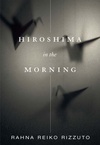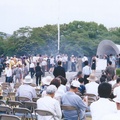On the 65th anniversary of the bombings of Hiroshima and Nagasaki, we risk losing the memories of the survivors.
I went to Hiroshima in 2001 to interview the hibakusha—literally, the “bomb-affected people.” I made this journey as a Japanese-American woman who had no knowledge of the atomic bombings—no experience of war at all.
When I got to Hiroshima in June 2001 and began my interviews, good-hearted people shared their testimonies with me, all beginning with where they were the moment they saw the plane, where they fled to, and who among their family and friends survived. Even those stories with some gore in them—descriptions of how the six rivers of the Hiroshima delta were so swollen with bodies that you couldn’t see the water—were curiously detached. It was not that they were afraid to offend the American interviewer. It was that they had forgotten precisely what it felt like.
The survivors recited the facts I had found in books: 100,000 dead within days, 100,000 more dying; everything within two kilometers irradiated; thirteen square kilometers burned to the ground. Drinking the water was deadly. Small fleshy body parts, like ears and noses, melted long before the people themselves died.
Often, the hibakusha ended our conversations with a speech about the need for peace and nuclear disarmament. There were even people who expressed their belief that the world was already at peace, and that, by dying spectacularly, the victims of Hiroshima had made it impossible for any sane leader to use nuclear weapons again.
I couldn’t bring myself to tell them that their sacrifice was almost invisible where I came from. Photos, film, documentation of the city had been confiscated and censored almost immediately after Japan surrendered, and the only indelible image of the bombing was the power of the bomb itself: the “shock and awe” version of the mushroom cloud. John Hersey’s Hiroshima, first published in 1946, remained the only “oral history” account released by a major, commercial American press. As a result, most Americans know almost nothing about nuclear fallout beyond the 1950’s advice to stock your bomb shelter with canned food.
But after September 11, 2001, when terrorism exploded on television, the interviews began to change.
Witnesses recalled being trapped under beams, screaming to be saved from the tornadoes of fire that were whipped up as the shock wave advanced. One woman I spoke with, who was about 8 at the time, told me about trying to fit her mother’s eye back into its socket. Another remembered giving her child water and watching his lips attach and pull off onto the spout of the kettle. One man said: “They brought my sister home, lying on a door. She died the next night, calling, ‘Mother, help me, please.’ My sister’s agony, her terrible burns, her skin slithering off…it was common at the time.”
The global instability—the terrorist attacks, the anthrax, the war in Afghanistan—had seeped into the past and made the kind of unconscious link between inhumanities that only trauma can. The hibakusha had been stripped of their trust in the future, and they passed that insecurity to me.
In 2001, living at the world’s first “ground zero” and watching on TV as my New York City home adopted that label, war seemed to be an act that could only be possible if we could fool ourselves into believing that other people’s children were not as precious, or human, as our own.
Hiroshima should have taught us not to be such fools.
This article was first published by the Progressive Media Project. When I sat down to write something for this anniversary, I realized that nothing has changed, except the date. So I changed the date.
* * * * *
For more information on my research in Hiroshima, go here:
http://www.r3reiko.com/books/hiroshima.html
Rizzuto’s upcoming memoir, Hiroshima in the Morning, will be published by Feminist Press in September 2010.
* * * * *
© 2010 Rahna Reiko Rizzuto




